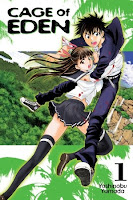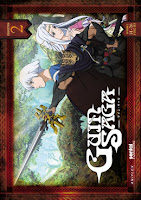My News and Reviews
So, I finally got around to my follow-up post about podcasts—Discovering Manga: Podcasts, Part 2. In it I talk about three podcasts that have regular manga content. If you’re interested, please check out the original podcast post, too—Discovering Manga: Podcasts. Also this past week, I posted my first in-depth manga review for the month, Blade of the Immortal, Volume 7: Heart of Darkness by Hiroaki Samura.
And speaking of Blade of the Immortal! Several people have mentioned interest in my reviews for the series, and so I’ve given myself a new goal. Beginning in April, I plan on reviewing one volume of Blade of the Immortal each month. Ideally this will be in addition to my regular in-depth manga reviews which, hopefully, means there will be three manga reviews each month! This will also allow me to catch up to current volume more quickly. It should take me about a year and a half. We’ll see how it goes, so fingers crossed!
There has been some exciting news this past week. The criminal charges have been dropped in the Canada customs case dealing with Ryan Matheson attempting to cross the border with manga on his laptop. His personal statement can be read on the Comic Book Legal Defense Fund website. Charles Brownstein, executive director of the CBLDF, also made some comments on lessons learned from the case. This past Thursday, Digital Manga announced on their blog that their account for Kindle publishing had been suspended. Thankfully, after an outpouring of support for the publisher, Amazon reversed their decision and Digital Manga’s Kindle account was restored on Friday.
On to slightly less vexing issues! Booklist has posted a core collection list for Japanese Manga for Adults. It’s a pretty great list with some fantastic selections that I can easily get behind. Also, this week is the Jiro Taniguchi Manga Moveable Feast, hosted by Manga Worth Reading. Over the last few weeks I’ve been reading, and mostly enjoying, a bunch of Taniguchi manga. I’ll have a review of A Zoo in Winter and a slew of Taniguchi manga quick takes later this week.
Quick Takes
 Blame!, Volume 1 by Tsutomu Nihei. If you have read and enjoyed Nihei’s more recent manga Biomega, you should probably check out Blame! as well. The two series are quite similar in many ways. The artwork and setting is dark, character designs are appropriately creepy, and action and environment take precedence over dialogue. Killy is a loner with a big gun, making his way up from the depths of the The City searching for anyone possessing Net Terminal Genes. Humans are just barely surviving, fighting amongst themselves and against terrifying creatures. No explanation is given as to what happened to bring humanity to its current state, but that’s not particularly important to the story at the moment.
Blame!, Volume 1 by Tsutomu Nihei. If you have read and enjoyed Nihei’s more recent manga Biomega, you should probably check out Blame! as well. The two series are quite similar in many ways. The artwork and setting is dark, character designs are appropriately creepy, and action and environment take precedence over dialogue. Killy is a loner with a big gun, making his way up from the depths of the The City searching for anyone possessing Net Terminal Genes. Humans are just barely surviving, fighting amongst themselves and against terrifying creatures. No explanation is given as to what happened to bring humanity to its current state, but that’s not particularly important to the story at the moment.
 Dengeki Daisy, Volume 4 by Kyousuke Motomi. Dengeki Daisy can be absolutely ridiculous at times, but I’m still enjoying the series. Probably because that even with all the potential for melodrama, it never takes itself too seriously. Teru is now aware that Kurosaki is Daisy, something that she had suspected, but decides to hide that fact from him because she’s afraid he’ll leave if he knows. More is revealed about the mystery surrounding her brother and his death in this volume as well as some of Daisy’s darker past (at which had previously been hinted). Motomi is very slowly doling out tidbits of information. I want to learn more, but I’m not frustrated yet by how little I actually do know. The character dynamics and interactions are also very interesting to watch.
Dengeki Daisy, Volume 4 by Kyousuke Motomi. Dengeki Daisy can be absolutely ridiculous at times, but I’m still enjoying the series. Probably because that even with all the potential for melodrama, it never takes itself too seriously. Teru is now aware that Kurosaki is Daisy, something that she had suspected, but decides to hide that fact from him because she’s afraid he’ll leave if he knows. More is revealed about the mystery surrounding her brother and his death in this volume as well as some of Daisy’s darker past (at which had previously been hinted). Motomi is very slowly doling out tidbits of information. I want to learn more, but I’m not frustrated yet by how little I actually do know. The character dynamics and interactions are also very interesting to watch.
 Kekkaishi, Omnibus 2 (equivalent to Volumes 4-6) by Yellow Tanabe. In the earlier volumes of Kekkaishi it seemed like Tanabe was just making things up as the series went along, but the manga seems to have a settled down somewhat. Granted, there are still some major plot developments and characters that are introduced out of nowhere. I am enjoying Kekkaishi quite a bit. I appreciate that brute strength is not seen to be the ultimate expression of power, but that knowledge and tactics are also extremely important. I also enjoy seeing the innovative ways that Tanabe comes up with to use the kekkai barriers. I certainly never expected them to be used for what amounts to aerial combat; that was pretty cool.
Kekkaishi, Omnibus 2 (equivalent to Volumes 4-6) by Yellow Tanabe. In the earlier volumes of Kekkaishi it seemed like Tanabe was just making things up as the series went along, but the manga seems to have a settled down somewhat. Granted, there are still some major plot developments and characters that are introduced out of nowhere. I am enjoying Kekkaishi quite a bit. I appreciate that brute strength is not seen to be the ultimate expression of power, but that knowledge and tactics are also extremely important. I also enjoy seeing the innovative ways that Tanabe comes up with to use the kekkai barriers. I certainly never expected them to be used for what amounts to aerial combat; that was pretty cool.
 Samurai Deeper Kyo, Volumes 1-2 by Akimine Kamijyo. I had high hopes for Samurai Deeper Kyo. I enjoy stories set in the Tokugawa era. I also thought the series conceit—two souls with vastly different personalities trapped in the same body—sounded interesting. Mibu Kyoshiro, a traveling medicine peddler and a bit of a goofball, fights for control over his body with Demon Eyes Kyo, a vicious killer. And there’s a bounty out for each of them. Despite their potential, I actually found the first couple of volumes Samurai Deeper Kyo to be a bit bland. Like the lead character’s split personality, it seems like the series hasn’t quite decided what it wants to be yet. The humor isn’t quite funny enough for it to be straight comedy, but the drama isn’t quite dramatic enough, either.
Samurai Deeper Kyo, Volumes 1-2 by Akimine Kamijyo. I had high hopes for Samurai Deeper Kyo. I enjoy stories set in the Tokugawa era. I also thought the series conceit—two souls with vastly different personalities trapped in the same body—sounded interesting. Mibu Kyoshiro, a traveling medicine peddler and a bit of a goofball, fights for control over his body with Demon Eyes Kyo, a vicious killer. And there’s a bounty out for each of them. Despite their potential, I actually found the first couple of volumes Samurai Deeper Kyo to be a bit bland. Like the lead character’s split personality, it seems like the series hasn’t quite decided what it wants to be yet. The humor isn’t quite funny enough for it to be straight comedy, but the drama isn’t quite dramatic enough, either.
 V. B. Rose, Volume 1 by Banri Hidaka. As I’m not particularly interested in weddings or wedding dresses, I wasn’t particularly expecting to enjoy the first volume of V. B. Rose. I was surprised by how much I ended up liking it. Ageha’s older sister is getting married which ultimately leads to Ageha helping out at the bridal shop Velvet Blue Rose when one of her sister’s dress designers injures his hand. The story in the first volume is fairly self-contained, which makes me wonder how Hidaka manages to stretch it out for fourteen volumes. Also, Yukari and Mitsuya (the designers) are totally a couple and are absolutely adorable together; no one will be able to convince me otherwise. Even if it is all in my imagination. Which it is.
V. B. Rose, Volume 1 by Banri Hidaka. As I’m not particularly interested in weddings or wedding dresses, I wasn’t particularly expecting to enjoy the first volume of V. B. Rose. I was surprised by how much I ended up liking it. Ageha’s older sister is getting married which ultimately leads to Ageha helping out at the bridal shop Velvet Blue Rose when one of her sister’s dress designers injures his hand. The story in the first volume is fairly self-contained, which makes me wonder how Hidaka manages to stretch it out for fourteen volumes. Also, Yukari and Mitsuya (the designers) are totally a couple and are absolutely adorable together; no one will be able to convince me otherwise. Even if it is all in my imagination. Which it is.
 Whisper of the Heart directed by Yoshifumi Kondō. Whisper of the Heart is a predecessor of sorts to The Cat Returns; both are based on manga by Aoi Hiiragi. As a librarian, I enjoyed seeing an old school library complete with card catalog and check out cards. The story simply couldn’t have happened in the same way with today’s computerized libraries and privacy concerns. Shizuku is a bookworm, so I couldn’t help but to feel some affinity with her. Her love of books and the library was endearing to me. However, I did find that I had little patience for all of the junior high school love drama. They’re all just so terribly earnest. I think it was supposed to be nostalgic, but it mostly made me roll my eyes. Still, the film did make me smile and even laugh on a few occasions.
Whisper of the Heart directed by Yoshifumi Kondō. Whisper of the Heart is a predecessor of sorts to The Cat Returns; both are based on manga by Aoi Hiiragi. As a librarian, I enjoyed seeing an old school library complete with card catalog and check out cards. The story simply couldn’t have happened in the same way with today’s computerized libraries and privacy concerns. Shizuku is a bookworm, so I couldn’t help but to feel some affinity with her. Her love of books and the library was endearing to me. However, I did find that I had little patience for all of the junior high school love drama. They’re all just so terribly earnest. I think it was supposed to be nostalgic, but it mostly made me roll my eyes. Still, the film did make me smile and even laugh on a few occasions.





